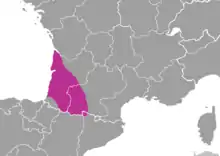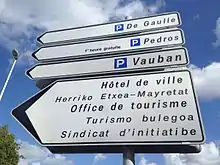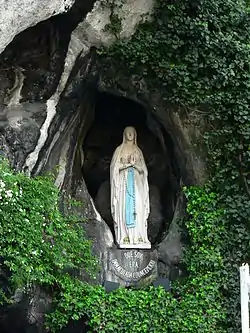Gascon language
Gascon (Occitan: [ɡasˈku(ŋ)], French: [ɡaskɔ̃]) is a variety of Romance spoken in southwest France. While often described as a dialect of Occitan, Gascon is considered by several authors to be a separate language altogether.[5][6][7]
| Gascon | |
|---|---|
| Pronunciation | [ɡasˈku(ŋ)] |
| Native to | France Spain |
| Region | Gascony |
Standard forms | |
| Official status | |
Official language in | |
| Language codes | |
| ISO 639-1 | oc |
| ISO 639-2 | gsc |
| ISO 639-3 | oci (code gsc was merged into oci in 2007)[1] |
| Glottolog | gasc1240 |
| ELP | Gascon[2] |
| IETF | oc-gascon[3][4] |
 Gascon speaking area | |
Gascon is mostly spoken in Gascony and Béarn in southwestern France (in parts of the following French départements: Pyrénées-Atlantiques, Hautes-Pyrénées, Landes, Gers, Gironde, Lot-et-Garonne, Haute-Garonne, and Ariège) and in the Aran Valley of Catalonia.
Aranese, a southern Gascon variety, is spoken in Catalonia and has been greatly influenced recently by Catalan and Spanish. Both these influences tend to differentiate it more and more from the dialects of Gascon spoken in France. Since the 2006 adoption of the new statute of Catalonia, Aranese is co-official with Catalan and Spanish in Catalonia (before, this status was valid for the Aran Valley only).
Linguistic classification
The majority of scholars think that Occitan constitutes a single language.
Some authors reject this opinion and even the name Occitan, thinking that there is a family of distinct lengas d'òc rather than dialects of a single language. Gascon, in particular, is distinct enough linguistically that it has been described as a language of its own.[5]
Basque substrate
The language spoken in Gascony before Roman rule was part of the Basque dialectal continuum (see Aquitanian language); the fact that the word 'Gascon' comes from the Latin root vasco/vasconem, which is the same root that gives us 'Basque', implies that the speakers identified themselves at some point as Basque. There is a proven Basque substrate in the development of Gascon.[8] This explains some of the major differences that exist between Gascon and other Occitan dialects.
A typically Gascon feature that may arise from this substrate is the change from "f" to "h". Where a word originally began with [f] in Latin, such as festa 'party/feast', this sound was weakened to aspirated [h] and then, in some areas, lost altogether; according to the substrate theory, this is due to the Basque dialects' lack of an equivalent /f/ phoneme, causing Gascon hèsta [ˈhɛsto] or [ˈɛsto]. A similar change took place in Spanish. Thus, Latin facere gives Spanish hacer ([aˈθer]) (or, in some parts of southwestern Andalusia, [haˈsɛɾ]).[9]
Although some linguists deny the plausibility of the Basque substrate theory, it is widely assumed that Basque, the "Circumpyrenean" language (as put by Basque linguist Alfonso Irigoyen and defended by Koldo Mitxelena, 1982), is the underlying language spreading around the Pyrenees onto the banks of the Garonne River, maybe as far east as the Mediterranean in Roman times (niska cited by Joan Coromines as the name of each nymph taking care of the Roman spa Arles de Tech in Roussillon, etc.).[10]:250–251 Basque gradually eroded across Gascony in the High Middle Ages (Basques from the Val d'Aran cited still circa 1000), with vulgar Latin and Basque interacting and mingling, but eventually with the former replacing the latter north of the east and middle Pyrenees and developing into Gascon.[10]:250, 255
However, modern Basque has had lexical influence from Gascon in words like beira ("glass"), polit ("pretty", Gascon polit/polida) to mention but a few. One way for the introduction of Gascon influence into Basque came about through language contact in bordering areas of the Northern Basque Country, acting as adstrate. The other one takes place since the 11th century over the coastal fringe of Gipuzkoa extending from Hondarribia to San Sebastian, where Gascon was spoken up to the early 18th century and often used in formal documents until the 16th century, with evidence of its continued occurrence in Pasaia in the 1870s.[11] A minor focus of influence was the Way of St James and the establishment of ethnic boroughs in several towns based on the privileges bestowed on the Francs by the Kingdom of Navarre from the 12th to the early 14th centuries, but the variant spoken and used in written records is mainly the Occitan of Toulouse.
Gascon varieties
Gascon is divided into three varieties or dialect sub-groups:[12]
- Western Gascon, which includes landese dialect and north-gascon (bazasais, high-landese and bordelese)
- Eastern or interior Gascon, known as parlar clar (Auch)
- Pyrenean or southern Gascon, which includes aranese dialect
Béarnais, the official language when Béarn was an independent state, does not correspond to a unified language: the three forms of Gascon are spoken in Béarn (in the south, Pyrenean Gascon, in the center and in the east, Eastern Gascon; to the north-west, Western Gascon).
| french | landese | béarnese and bigourdan | aranese | commingois and couseranais | interior gascon | bazadais and high-landese | bordelese | |
|---|---|---|---|---|---|---|---|---|
affirmation: He is going |
Il y va | Qu' i va. | Que i va. | I va. | Que i va. | Que i va. | (Qu’) i va/vai. | I vai. |
negation:He wasn't listening to him |
il ne l’écoutait pas | ne l’escotèva pas | non / ne l’escotava pas | non la escotaua | non l’escotava cap | ne l’escotava pas | (ne) l’escotèva pas | ne l'escotava pas/briga |
plural formation:the young men – the young women |
les jeunes hommes – les jeunes filles | los gojats – las gojatas | eths / los gojats – eras / las gojatas | es gojats – es gojates | eths gojats – eras gojatas | los gojats – las gojatas | los gojats – las gojatas | los gojats – las dònas/gojas |
Usage of the language

A poll conducted in Béarn in 1982 indicated that 51% of the population could speak Gascon, 70% understood it, and 85% expressed a favourable opinion regarding the protection of the language.[13] However, use of the language has declined dramatically over recent years as a result of the Francization taking place during the last centuries, as Gascon is rarely transmitted to young generations any longer (outside of schools, such as the Calandretas).
The usual term for Gascon is "patois", a word designating in France a non-official and usually devaluated dialect (such as Gallo) or language (such as Occitan), regardless of the concerned region. It is mainly in Béarn that the population uses concurrently the term "Béarnais" to designate its Gascon forms. This is because of the political past of Béarn, which was independent and then part of a sovereign state (the shrinking Kingdom of Navarre) from 1347 to 1620.
In fact, there is no unified Béarnais dialect, as the language differs considerably throughout the province. Many of the differences in pronunciation can be divided into east, west, and south (the mountainous regions). For example, an 'a' at the end of words is pronounced "ah" in the west, "o" in the east, and "œ" in the south. Because of Béarn's specific political past, Béarnais has been distinguished from Gascon since the 16th century, not for linguistic reasons.
Influences on other languages
Probably as a consequence of the linguistic continuum of occidental Romania and the French influence over the Hispanic Mark on the medieval times, shared similar and singular features are noticeable between Gascon and other Latin languages on the other side of the frontier: Aragonese and ultraoccidental Catalan (Catalan of La Franja). Gascon is also (with Spanish, Navarro-Aragonese and French) one of the Romance influences in Basque language.
Examples

| Word | Translation | IPA |
|---|---|---|
| Earth | tèrra | [ˈtɛrrɔ] |
| heaven | cèu | [ˈsɛw] |
| water | aiga | [ˈajɣɔ] |
| fire | huec | [ˈ(h)wɛk] |
| man | òmi/òme | [ˈɔmi]/[ˈɔme] |
| woman | hemna | [ˈ(h)ennɔ] |
| eat | minjar/manjar | [minˈʒa]/[manˈ(d)ʒa] |
| drink | béver | [ˈbewe]/[ˈbeβe] |
| big | gran | [ˈɡran] |
| little | petit/pichon/pichòt | [peˈtit]/[piˈtʃu]/[piˈtʃɔt] |
| night | nueit | [ˈnɥejt] |
| day | dia/jorn | [ˈdia]/[ˈ(d)ʒur] |
References
- "639 Identifier Documentation: gsc". SIL International.
- Endangered Languages Project data for Gascon.
- "Occitan (post 1500)". IANA language subtag registry. 18 August 2008. Retrieved 11 February 2019.
- "Gascon"; IANA language subtag registry; subtitle: Occitan variant spoken in Gascony; retrieved: 11 February 2019; publication date: 22 April 2018.
- Cf. Rohlfs, Gerhard. 1970. Le Gascon. Études de philologie pyrénéenne, 2e éd. Tubingen, Max Niemeyer, & Pau, Marrimpouey jeune.
- Chambon, Jean-Pierre; Greub, Yan (2002). "Note sur l'âge du (proto)gascon". Revue de Linguistique Romane (in French). 66: 473–495.
- Stephan Koppelberg, El lèxic hereditari caracteristic de l'occità i del gascó i la seva relació amb el del català (conclusions d'un analisi estadística), Actes del vuitè Col·loqui Internacional de Llengua i Literatura Catalana, Volume 1 (1988). Antoni M. Badia Margarit & Michel Camprubi ed. (in Catalan)
- Allières, Jacques (2016). The Basques. Reno: Center for Basque Studies. pp. xi. ISBN 9781935709435.
- A. R. Almodóvar: Abecedario andaluz, Ediciones Mágina. Barcelona, 2002
- Jimeno Aranguren, Roldan (2004). Lopez-Mugartza Iriarte, J.C. (ed.). Vascuence y Romance: Ebro-Garona, Un Espacio de Comunicación. Pamplona: Gobierno de Navarra / Nafarroako Gobernua. ISBN 84-235-2506-6.
- "LOS GASCONES EN GUIPÚZCOA". IMPRENTA DE LA DIPUTACION DE GUIPUZCOA. Retrieved 12 April 2009. Site in Spanish
- Classification of X. Ravier according to the "Linguistic Atlas of Gascony". Covered in particular by D. Sumien, “Classificacion dei dialèctes occitans”, “Linguistica occitana”, 7, September 2009, online
- Ethnologue report for Gascon, 15th edition
External links
| Wikimedia Commons has media related to Gascon language. |
- Museum of local culture
- Teaching of Occitan and Basque in Aquitania
- Cap'òc : Unitat d'Animacion Pedagogica en Occitan
- Gascon Lanas (Institut d'Estudis Occitans)
- Per Noste
- IBG site opposing Gascon and Béarnais to Occitan
- IRC chat room devoted to the Gascon language
- A Vòste, Gascon language journal
- Lo gascon lèu e plan ("Gascon quick and well"), an instruction set for learning the language (in French)